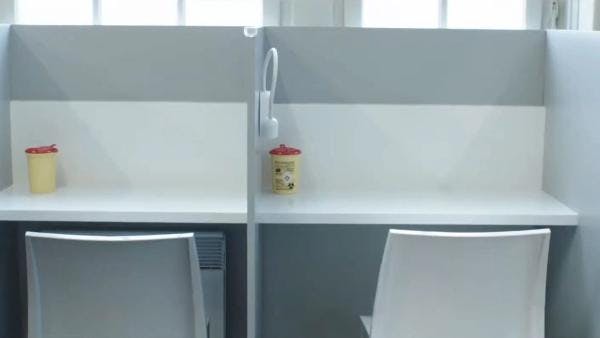Screenshot from 'Argos : la salle de consommation à moindre risque à Strasbourg', a video by Tchapp. https://youtu.be/KOTDQhkz4nw
Impact of drug consumption rooms on non-fatal overdoses, abscesses and emergency department visits in people who inject drugs in France
By P Roux, M Jauffret-Roustide, C Donadille, L Briand Madrid, C Denis, I Célérier, C Chauvin, N Hamelin, G Maradan, M P Carrieri, C Protopopescu, L Lalanne, M Auriacombe, COSINUS Study Group
Abstract
Background: The effectiveness of drug consumption rooms (DCRs) for people who inject drugs (PWID) has been demonstrated for HIV and hepatitis C virus risk practices, and access to care for substance use disorders. However, data on other health-related complications are scarce. Using data from the French COSINUS cohort, we investigated the impact of DCR exposure on non-fatal overdoses, abscesses and emergency department (ED) visits, all in the previous 6 months.
Methods: COSINUS is a 12-month prospective cohort study of 665 PWID in France studying DCR effectiveness on health. We collected data from face-to-face interviews at enrolment, and at 6 and 12 months of follow-up. After adjusting for other correlates (P-value < 0.05), the impact of DCR exposure on each outcome was assessed using a two-step Heckman mixed-effects probit model, allowing us to adjust for potential non-randomization bias due to differences between DCR-exposed and DCR-unexposed participants, while taking into account the correlation between repeated measures.
Results: At enrolment, 21%, 6% and 38% of the 665 participants reported overdoses, abscesses and ED visits, respectively. Multivariable models found that DCR-exposed participants were less likely to report overdoses [adjusted coefficient (95% CI): -0.47 (-0.88; -0.07), P = 0.023], abscesses [-0.74 (-1.11; -0.37), P < 0.001] and ED visits [-0.74 (-1.27; -0.20), P = 0.007].
Conclusion: This is the first study to show the positive impact of DCR exposure on abscesses and ED visits, and confirms DCR effectiveness in reducing overdoses, when adjusting for potential non-randomization bias. Our findings strengthen the argument to expand DCR implementation to improve PWID injection environment and health.
Keywords: Safer injecting facility; abscess; emergency department; injection drug users; overdose; risk environment; skin and soft tissue infections.
© The Author(s) 2022; all rights reserved. Published by Oxford University Press on behalf of the International Epidemiological Association.
